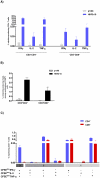A DNA vaccine encoding multiple HIV CD4 epitopes elicits vigorous polyfunctional, long-lived CD4+ and CD8+ T cell responses
- PMID: 21347287
- PMCID: PMC3037933
- DOI: 10.1371/journal.pone.0016921
A DNA vaccine encoding multiple HIV CD4 epitopes elicits vigorous polyfunctional, long-lived CD4+ and CD8+ T cell responses
Abstract
T-cell based vaccines against HIV have the goal of limiting both transmission and disease progression by inducing broad and functionally relevant T cell responses. Moreover, polyfunctional and long-lived specific memory T cells have been associated to vaccine-induced protection. CD4(+) T cells are important for the generation and maintenance of functional CD8(+) cytotoxic T cells. We have recently developed a DNA vaccine encoding 18 conserved multiple HLA-DR-binding HIV-1 CD4 epitopes (HIVBr18), capable of eliciting broad CD4(+) T cell responses in multiple HLA class II transgenic mice. Here, we evaluated the breadth and functional profile of HIVBr18-induced immune responses in BALB/c mice. Immunized mice displayed high-magnitude, broad CD4(+)/CD8(+) T cell responses, and 8/18 vaccine-encoded peptides were recognized. In addition, HIVBr18 immunization was able to induce polyfunctional CD4(+) and CD8(+) T cells that proliferate and produce any two cytokines (IFNγ/TNFα, IFNγ/IL-2 or TNFα/IL-2) simultaneously in response to HIV-1 peptides. For CD4(+) T cells exclusively, we also detected cells that proliferate and produce all three tested cytokines simultaneously (IFNγ/TNFα/IL-2). The vaccine also generated long-lived central and effector memory CD4(+) T cells, a desirable feature for T-cell based vaccines. By virtue of inducing broad, polyfunctional and long-lived T cell responses against conserved CD4(+) T cell epitopes, combined administration of this vaccine concept may provide sustained help for CD8(+) T cells and antibody responses- elicited by other HIV immunogens.
Conflict of interest statement
Figures






Similar articles
-
A Recombinant Adenovirus Encoding Multiple HIV-1 Epitopes Induces Stronger CD4+ T cell Responses than a DNA Vaccine in Mice.J Vaccines Vaccin. 2011 Dec 2;2(4):1000124. doi: 10.4172/2157-7560.1000124. J Vaccines Vaccin. 2011. PMID: 23814696 Free PMC article.
-
A promiscuous T cell epitope-based HIV vaccine providing redundant population coverage of the HLA class II elicits broad, polyfunctional T cell responses in nonhuman primates.Vaccine. 2022 Jan 21;40(2):239-246. doi: 10.1016/j.vaccine.2021.11.076. Epub 2021 Dec 24. Vaccine. 2022. PMID: 34961636
-
Broad and cross-clade CD4+ T-cell responses elicited by a DNA vaccine encoding highly conserved and promiscuous HIV-1 M-group consensus peptides.PLoS One. 2012;7(9):e45267. doi: 10.1371/journal.pone.0045267. Epub 2012 Sep 18. PLoS One. 2012. PMID: 23028895 Free PMC article.
-
Multiple Approaches for Increasing the Immunogenicity of an Epitope-Based Anti-HIV Vaccine.AIDS Res Hum Retroviruses. 2015 Nov;31(11):1077-88. doi: 10.1089/AID.2015.0101. Epub 2015 Aug 13. AIDS Res Hum Retroviruses. 2015. PMID: 26149745 Review.
-
Development of a DNA-MVA/HIVA vaccine for Kenya.Vaccine. 2002 May 6;20(15):1995-8. doi: 10.1016/s0264-410x(02)00085-3. Vaccine. 2002. PMID: 11983261 Review.
Cited by
-
A nonviral pHEMA+chitosan nanosphere-mediated high-efficiency gene delivery system.Int J Nanomedicine. 2013;8:1403-15. doi: 10.2147/IJN.S43168. Epub 2013 Apr 11. Int J Nanomedicine. 2013. PMID: 23610520 Free PMC article.
-
Conservation of HIV-1 T cell epitopes across time and clades: validation of immunogenic HLA-A2 epitopes selected for the GAIA HIV vaccine.Vaccine. 2012 Dec 14;30(52):7547-60. doi: 10.1016/j.vaccine.2012.10.042. Epub 2012 Oct 24. Vaccine. 2012. PMID: 23102976 Free PMC article.
-
Poly(I:C) Potentiates T Cell Immunity to a Dendritic Cell Targeted HIV-Multiepitope Vaccine.Front Immunol. 2019 Apr 24;10:843. doi: 10.3389/fimmu.2019.00843. eCollection 2019. Front Immunol. 2019. PMID: 31105693 Free PMC article.
-
The Question of HIV Vaccine: Why Is a Solution Not Yet Available?J Immunol Res. 2024 Apr 8;2024:2147912. doi: 10.1155/2024/2147912. eCollection 2024. J Immunol Res. 2024. PMID: 38628675 Free PMC article. Review.
-
A Recombinant Adenovirus Encoding Multiple HIV-1 Epitopes Induces Stronger CD4+ T cell Responses than a DNA Vaccine in Mice.J Vaccines Vaccin. 2011 Dec 2;2(4):1000124. doi: 10.4172/2157-7560.1000124. J Vaccines Vaccin. 2011. PMID: 23814696 Free PMC article.
References
Publication types
MeSH terms
Substances
LinkOut - more resources
Full Text Sources
Research Materials

